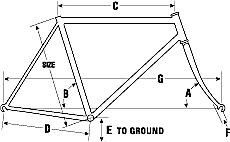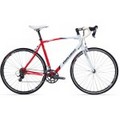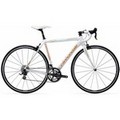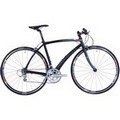What Makes a Touring Bicycle Frame

When it comes to choosing a perfect touring bicycle frame, what is right for one person on a certain tour doesn’t mean it is right for another person on their tour. So features can vary from one bicycle frame to another. Which features should dictate your choice?
Which Frame Material
Most modern bicycle frames are made from either hi-tensile, cromoly steel, aluminum, titanium, or carbon composite. In the past, almost all touring bicycles were constructed using hi-tensile or cromoly steel. Even today, small and medium manufacturers construct their serious touring bicycles from various alloys of hi-tensile or cromoly steel. However, an increasing number of aluminum frame manufacturers are producing very light, strong, and affordable touring frames. But is aluminum or even titanium the answer for an old material like steel for touring bicycles.
Steel Alloys
Basically, all the available steel alloys have the same stiffness and weights. But in the manufacture of bicycle tubing, chromium and molybendum is added to increase its strength. This addition allows the tubes to be thinned out in the middle and thicker at the ends, making a lighter frame. Consequently, steel frames tend to have slender tubes compared with aluminum frames.
The use of thinner tubes enables the frame to have a more flexible feel than aluminum. This flex makes for a more comfortable ride without adding a carbon fork, seat post, or frame tubes. And on a long ride, a little flexibility goes a long way.
In summary for steel alloy frames, they are strong, tough, comfortable, lightweight, affordable, and repairable. I believe that a high quality steel alloy frame should be your first choice for a touring bicycle frame.
Aluminum
Aluminum has become one of the most common material for high-quality, mass- produced bicycles. An aluminum frame is light, responsive, rust proof, and affordable. Its stiffness and lightness as a bicycle frame is superior to a comparable steel alloy frame.
Aluminum is less dense than steel. To get a stiff but light frame, the diameter of the tube is increase while maintaining the wall thickness. This oversized tube results in a lighter but stiffer frame than with steel. But the stiffness can feel a little too harsh for some bicycle tourist. Some cyclists add carbon fiber forks and seat post to dampen some of the harshness.
Titanium
Titanium is an excellent frame building material due to its strength and lightness. However, it is very expensive due to material and fabricating costs. The strength of titanium as a frame material is comparable to steel, but a stiff titanium tube will have a larger diameter than comparable steel tube. The two main advantages of titanium are due to its lightness and resistance to corrosion compared to alloy steels. But the excessive cost limits its availability as a touring bicycle.
The Best Frame Geometry
The frame geometry of a traditional touring bicycle is designed for long hours on the road. Basically, a touring frame differs from other bicycles (e.g., racing, sport, and hybrid frames) in a number of ways. These differences allow a more comfortable and stable ride while under heavy gear loads. Steering needs to be less sensitive, the center of gravity lower, and your body posture more upright. The factors that determine these benefits are shown on the figure below.

- All dimensions given here are based on a 54cm seat tube frame size and can change significantly due to the frame design.
- A more laid back head tube angle ‘A’ around 71° brings the handlebar closer toward you for a more upright posture with the correct sized stem.
- Longer chainstays ‘D’ gives you more pannier clearance for your heel. It also moves your pannier further from your bottom bracket so that weight is distributed better between both wheels. A chainstay length greater than 450mm is a good rule of thumb.
- A bottom bracket height above the ground ‘E’ around 270mm keeps the center of gravity low. This aids in the stability of the bicycle under heavy loads.
- A long wheel base ‘G’ around 1055mm for better steering and stability under heavy loads.
Recommended Touring Frame Features
- Braze-ons for fender mounts
- Minimum of 2 water bottle mounts (3 bottle mounts is better)
- Braze-ons for front and rear racks
- Front and rear wheel clearance for mininum 38mm tires with fenders
- 700c or 26″ wheels
- Brake bosses for cantilever or V-brakes
- Recently, some high-end touring bike utilize disc brakes. The stopping power of dis brakes is definitely superior to other brakes (especially in wet and muddy conditions); however, they may be overkill for most touring. Yet for heavily loaded expedition and tandem bikes, dis brakes are definitely needed for the increased stopping power.




HI John- I am retired and now I want to start touring and I do not know much about fancy bikes as i ride a 40 lb cheap bike. I have settled on a Surly LHT Deluxe Frame and build it out, so if money not a option what would you sagest for rim, handlebars, brakes, crank, gears, rack and packs.
John
Hello John!
Leanne here.
The Surly LHT Deluxe is an excellent choice for your first touring bike! Touring is also an awesome way to spend your free time, so you have a lot of rewarding, exhilarating hours on the road in your future. You should always try gear first before making a purchase to make sure it fits your body’s specific needs, but here’s what I’d do with the Surly.
As for the handlebars, you should replace the stock set with the Salsa Woodchipper handlebars. They’re basic for any riding style, but they also give you more flexibility with your positioning. However, they’re very much a bare-bones model, so you’d have to apply your own tape and padding if desired.
For brakes, there’s a never-ending battle between people who prefer disc brakes and those who prefer rim brakes. Disc brakes work at the center of the wheel, while rim brakes work around the rim. Personally, I prefer rim brakes. They’re more versatile, and the system is simple so you can repair them on your own with little to know technical bike knowledge. I recommend the Eecycle Works Ebrake. The system is lightweight and powerful.
Above all, I prefer cranks that are universal. When you’re on the road touring and you run into any trouble with the crank set, a more standard size makes it more likely that a local repair shop will have the necessary equipment on hand to fix it. Without it, you’d need to stop overnight or even longer until the parts are ordered. I like the 5-bolt 110mm crank by Nashbar.
When you’re touring, it’s unlikely that you’ll be wishing you had a lower gear available. Lots of gears will weight your bike down, and on long tours you’ll prefer a more lightweight bike. Depending on how many gears you’re interested in, I’d recommend any set from Shimano. Your gear preference should be based on the terrain and your own strength.
If you’re in it for the long haul, you’ll definitely want a good rack for your touring gear needs. Your racks and packs will both depend on what you’re thinking of bringing with you on your trip. I prefer leaving the front of my back as light as possible, so I’ll recommend my favorite rear rack. The Blackburn Expedition has multiple tie-down points for panniers (I recommend the Ortlieb panniers), and the aluminum rack bars are lightweight.
I hope this helps! Enjoy your cycling adventures, and keep us posted about your journeys!
Leanne
Clear, inrfemativo, simple. Could I send you some e-hugs?
solid advise
Hi John. i decided to use bicycle for work. I am planning to use it 100 km per day for 10 days a month. after two months of searching, i still cant decide about my handlebars and frame geometry. i found three kind of frames, they both have same A angle around 70, they all have same top tube lenght (i dont know how they have more comfortable and upright riding position)
1- a touring bike has a drop bar, heavy(15kg), has carriers etc, and strong frame
2- a cyclecross frame, costly, has a drop bar, light(10kg), can add carriers and weak frame
3- a fitness bike, has a rised bar, light(10kg), can add carriers, weak frame
cant decide.
im using a rised handle bar for my hybrid bike now, im not really confortable(maybe frame is bir for me) and im scared if i buy a drop bar, im gonna have to use my bike with a lower posture. i will be glad if you can help me
A fascinating discussion is definitely worth comment.
There’s no doubt that that you need to write more on this topic, it
might not be a taboo matter but generally people don’t talk about these topics.To the next!
Manyy thanks!!
Hi there, the whole thing is going well here and ofcourse every one is sharing data, that’s truly good, keep up writing.